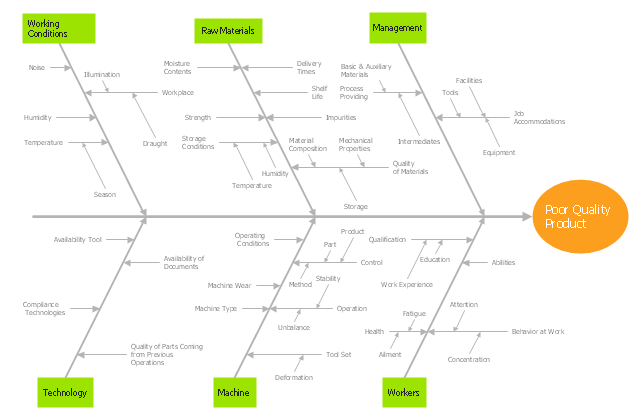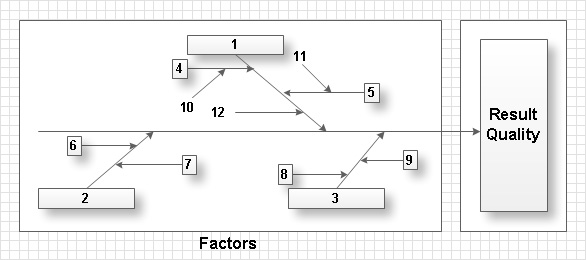 Fishbone Diagram
Fishbone Diagram
Fishbone Diagrams solution extends ConceptDraw PRO software with templates, samples and library of vector stencils for drawing the Ishikawa diagrams for cause and effect analysis.
"Ishikawa diagrams (also called fishbone diagrams, herringbone diagrams, cause-and-effect diagrams, or Fishikawa) are causal diagrams created by Kaoru Ishikawa (1968) that show the causes of a specific event. Common uses of the Ishikawa diagram are product design and quality defect prevention, to identify potential factors causing an overall effect. Each cause or reason for imperfection is a source of variation. Causes are usually grouped into major categories to identify these sources of variation. The categories typically include:
- People: Anyone involved with the process
- Methods: How the process is performed and the specific requirements for doing it, such as policies, procedures, rules, regulations and laws
- Machines: Any equipment, computers, tools, etc. required to accomplish the job
- Materials: Raw materials, parts, pens, paper, etc. used to produce the final product
- Measurements: Data generated from the process that are used to evaluate its quality
- Environment: The conditions, such as location, time, temperature, and culture in which the process operates" [Ishikawa diagram. Wikipedia]
The fishbone diagram example "Causes of low-quality output" was created using the ConceptDraw PRO diagramming and vector drawing software extended with the Fishbone Diagrams solution from the Management area of ConceptDraw Solution Park.
- People: Anyone involved with the process
- Methods: How the process is performed and the specific requirements for doing it, such as policies, procedures, rules, regulations and laws
- Machines: Any equipment, computers, tools, etc. required to accomplish the job
- Materials: Raw materials, parts, pens, paper, etc. used to produce the final product
- Measurements: Data generated from the process that are used to evaluate its quality
- Environment: The conditions, such as location, time, temperature, and culture in which the process operates" [Ishikawa diagram. Wikipedia]
The fishbone diagram example "Causes of low-quality output" was created using the ConceptDraw PRO diagramming and vector drawing software extended with the Fishbone Diagrams solution from the Management area of ConceptDraw Solution Park.
Total Quality Management with ConceptDraw
Total Quality Management (TQM) system is the management method where the confidence in quality of all organization processes is placed foremost. The given method is widely used in production, in educational system, in government organizations and so on.- Cause and Effect Analysis ( Fishbone Diagrams )
- Fishbone Diagram | Business Productivity Diagramming | Business ...
- Cause and Effect Analysis ( Fishbone Diagrams ) | Business ...
- Fishbone Diagram | Business Productivity Diagramming | Entity ...
- Ishikawa diagram - Factors reducing competitiveness | Business ...
- Cause and Effect Analysis ( Fishbone Diagrams ) | Fishbone Diagram ...
- SWOT Sample in Computers | Fishbone Diagram | Restaurant Floor ...
- Fishbone Diagram | Entity-Relationship Diagram (ERD) | UML ...
- Business Productivity Diagramming | Ishikawa diagram - Factors ...
- Business Productivity Diagramming | Fishbone Diagram | Business ...
- Entity-Relationship Diagram (ERD) | Venn diagrams with ...
- Fishbone Diagram
- SWOT analysis matrix diagram templates | SWOT Analysis ...
- Fishbone Diagram | Quality fishbone diagram template | Fishbone ...
- Fishbone Diagram | Fishbone diagram - Production process | Total ...
- Business Productivity Diagramming | Fishbone Diagram | Ishikawa ...
- Fishbone diagram - Causes of low-quality output | Total Quality ...
- Fishbone Diagram | Event-driven Process Chain Diagrams EPC ...
- Entity-Relationship Diagram (ERD) | Network Diagram Examples ...
- Total Quality Management TQM Diagrams | Fishbone Diagram ...

